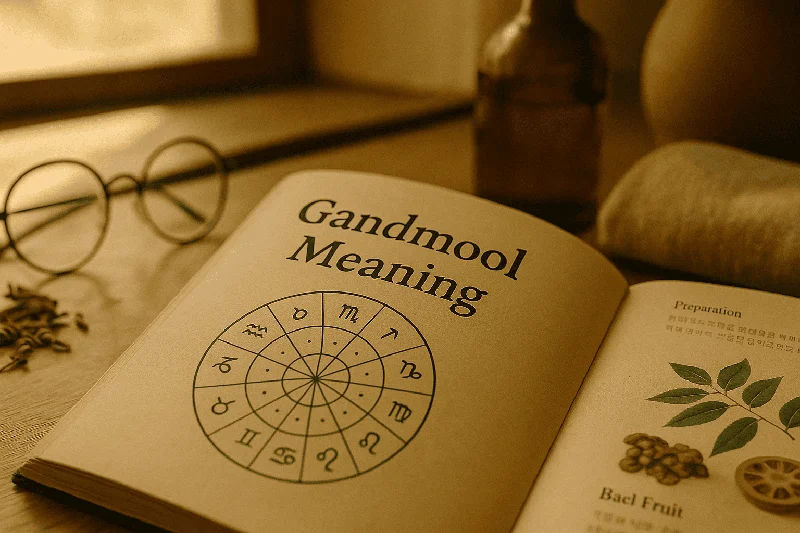Ask Ayurvedic doctor a question and get a consultation online on the problem of your concern in a free or paid mode. More than 2,000 experienced doctors work and wait for your questions on our site and help users to solve their health problems every day.
Shop Now in Our Store
Gandmool Meaning – Astrological Insights into Ganda Mool Nakshatras

Introduction
In Vedic astrology, the term "Gandmool" (often rendered as "Ganda Mool") holds a unique place, referring to certain nakshatras (lunar mansions) that are traditionally considered inauspicious. However, this inauspicious label is not absolute; it depends on various factors, including planetary rulership and the positions of celestial bodies. Understanding the Gandmool meaning requires a deep dive into the roles of planetary influences—specifically Ketu and Mercury—and the dynamic energies present when nakshatras are at the conjunction of two zodiac signs.
Ganda Mool Nakshatras: An Overview
Astrological Definition
Ganda Mool nakshatras are defined by their association with certain planetary rulers and their position at the junction of two zodiac signs. These nakshatras often carry a reputation for being challenging or inauspicious. The term "Ganda Mool" implies that there may be hidden or potentially disruptive influences at work; however, this does not mean that these nakshatras are doomed to bring only negative outcomes.
Planetary Influences
The inauspicious nature of Ganda Mool is closely linked with the influence of either Ketu or Mercury:
- Ketu-Ruled Nakshatras: These are considered to have transformative energy. Ketu, being a shadow planet, is associated with detachment, spiritual liberation, and sometimes sudden changes or disruptions. The Ketu Ganda Mool nakshatras include Ashwini, Magha, and Mool. Their association with Ketu often signifies a need for inner transformation and spiritual growth, even if the initial impact might seem challenging.
- Mercury-Ruled Nakshatras: In some interpretations, certain Mercury-ruled nakshatras that lie at the border between two signs can also be classified as Ganda Mool. Mercury’s influence emphasizes communication, intellect, and analytical skills, yet in these positions, there may be a tendency toward mental restlessness or indecisiveness.
Conjunction of Two Signs
An essential feature of Ganda Mool nakshatras is their location at the conjunction of two zodiac signs. This transitional position intensifies their energies, often leading to a blending or clashing of characteristics from both signs. Such intersections can create moments of ambiguity, where the inherent traits of the nakshatra may manifest in unexpected or disruptive ways.
Inauspicious, Yet Not Always Negative
Understanding the Dual Nature
While Ganda Mool nakshatras have been traditionally considered inauspicious, modern interpretations in Vedic astrology recognize that they also carry the potential for significant positive transformation. The challenges associated with these nakshatras are not definitive markers of misfortune but rather invitations to overcome obstacles and grow spiritually.
- Transformative Potential: The influence of Ketu, for instance, encourages individuals to let go of old patterns and embrace change. Although this process can be unsettling, it ultimately leads to personal evolution and greater self-awareness.
- Catalysts for Growth: The dynamic energy at the conjunction of two signs can serve as a catalyst for innovation and creative problem-solving. Individuals with prominent Ganda Mool influences may develop unique coping mechanisms that empower them to navigate life’s complexities.
Context Matters
It is crucial to consider the entire natal chart when assessing the impact of a Ganda Mool nakshatra. Factors such as planetary aspects, house placements, and overall doshic balance can significantly mitigate or even enhance the challenging aspects of these nakshatras. An experienced astrologer can provide insights into how to harness the transformative energy of Ganda Mool for personal benefit.
The Ketu Ganda Mool Nakshatras
Ashwini
- Characteristics: As the first nakshatra in the zodiac, Ashwini is ruled by Ketu and symbolizes initiation and swift movement.
- Energy: It brings a burst of energy that can lead to rapid changes, urging individuals to embark on new beginnings. Despite its challenging reputation, Ashwini is also associated with healing and rejuvenation.
Magha
- Characteristics: Magha, also under the influence of Ketu, is linked with ancestral heritage, authority, and power.
- Energy: This nakshatra imbues individuals with leadership qualities and a sense of responsibility. While its energy can sometimes be overwhelming, it offers the opportunity to reconnect with one’s roots and claim personal power.
Mool
- Characteristics: Mool represents the foundational energies of life. Governed by Ketu, it is associated with profound change and the dissolution of existing structures.
- Energy: Mool challenges individuals to strip away illusions and discover deeper truths about themselves. Although it may initially bring upheaval, the long-term outcome is often spiritual clarity and liberation.
Harnessing the Energy of Ganda Mool
Remedies and Mitigation Strategies
Astrological remedies can help balance the energies of Ganda Mool nakshatras:
- Mantras and Meditation: Reciting specific mantras related to Ketu and engaging in regular meditation can help calm the disruptive energies.
- Gemstone Therapy: Wearing gemstones recommended by an experienced astrologer may counteract negative influences.
- Lifestyle Adjustments: Embracing a disciplined lifestyle, including a balanced diet and regular spiritual practices, can provide stability amid change.
Embracing Transformation
Ultimately, understanding Gandmool meaning from an astrological perspective is about embracing the inherent duality of challenge and growth. While the Ganda Mool nakshatras—Ashwini, Magha, and Mool—may present difficulties, they also offer powerful opportunities for transformation and self-discovery.
Conclusion
Gandmool meaning in Vedic astrology is a complex and nuanced concept. The Ganda Mool nakshatras, especially those ruled by Ketu like Ashwini, Magha, and Mool, are often labeled inauspicious due to their potential for disruption. Yet, these nakshatras are not solely harbingers of misfortune; they also pave the way for deep transformation and spiritual growth. By understanding and harnessing the energy of Ganda Mool, individuals can transform challenges into stepping stones toward a more enlightened and balanced life.
References & Further Reading
- B. V. Raman, Astrology for You – A comprehensive guide to understanding Vedic astrology and the roles of nakshatras.
- Hart de Fouw & Robert Svoboda, Light on Life: An Introduction to the Astrology of India – Explores the deeper spiritual dimensions of Vedic astrology.
- David Frawley, Yoga and Ayurveda: Self-Healing and Self-Realization – Discusses the interplay between Ayurvedic principles and astrological influences.
- Vedic Astrology Texts & Commentaries – Traditional texts provide foundational insights into nakshatra classifications and planetary rulership.
This article is checked by the current qualified Dr Sujal Patil and can be considered a reliable source of information for users of the site.


